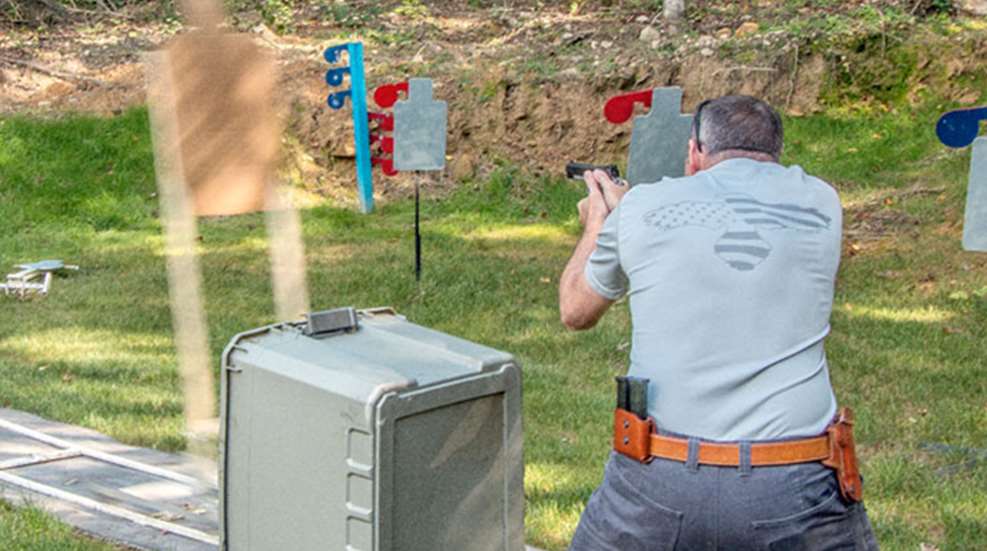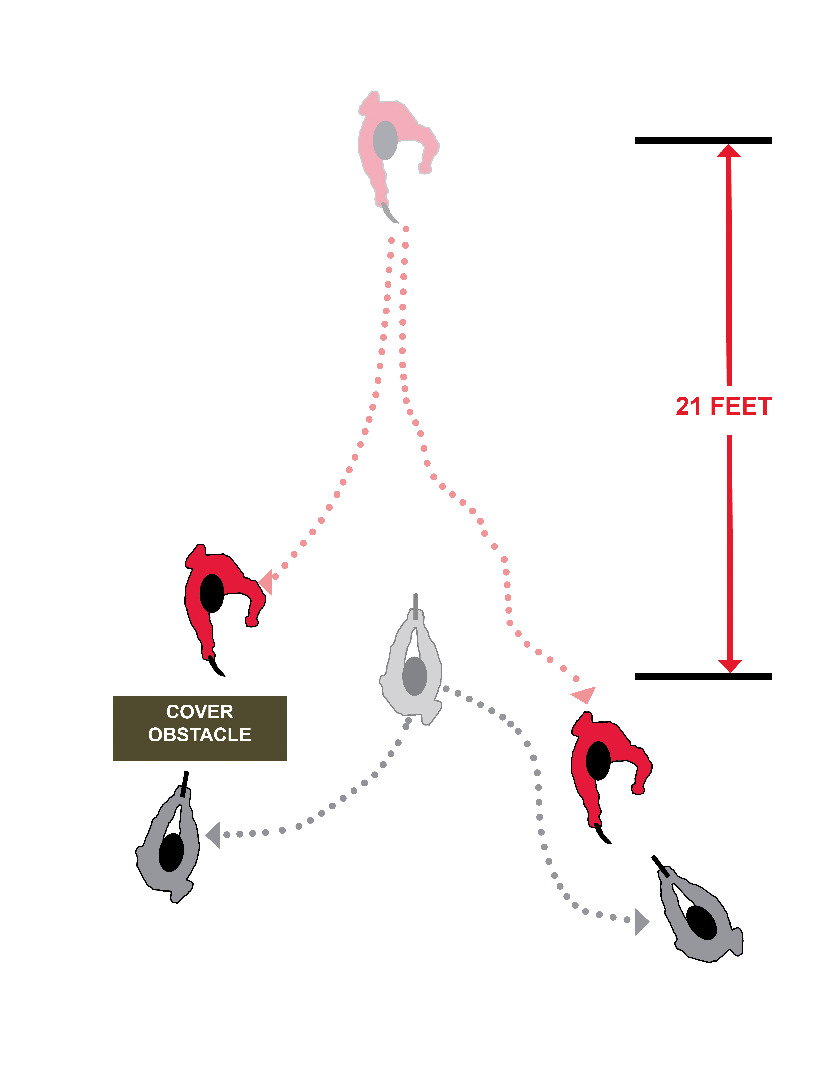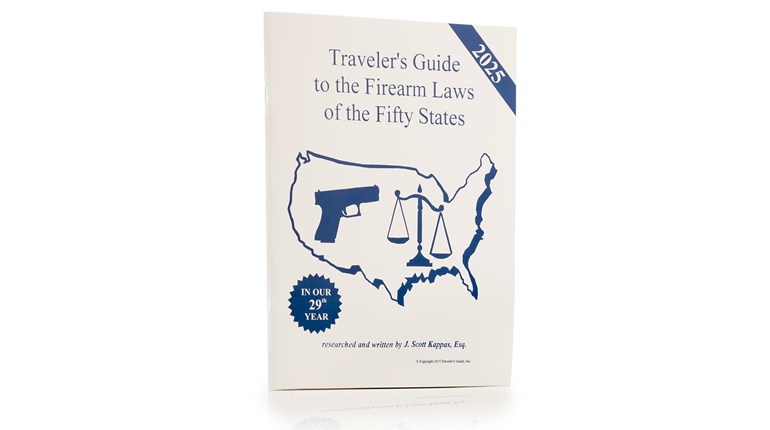
Shown above, author Richard Mann practices the Tueller Drill, a practice drill developed under the auspices of the 21-foot rule, with the MGM Targets Attack Target.
In 1983, an article written by a Salt Lake City police officer named Dennis Tueller was published in a law enforcement journal. The article was titled “How Close is too Close?” It dealt with the premise of a man armed with a holstered handgun defending against a man armed with a striking or stabbing instrument. Through experimentation, Tueller developed what became known as the "21-Foot Rule," which concluded if a bad guy armed with a knife or a club was within 21 feet of you, the reasonable conclusion would be you were within his danger zone. In other words, the bad guy could cover 21 feet in about 1.5 seconds—before you could draw your handgun and neutralize the threat.
Two important things occurred as a result of Tueller’s observation and the resulting article. As trainers became aware of Tueller’s postulate, various drills appeared that were designed to replicate this 7-yard assault. The cumulative result of trainers and students practicing these drills, talking about them and writing about them was a tactical axiom: If an armed individual was within 21 feet of you, you would be justified in shooting to defend yourself.
According to Dave Starin, retired SWAT officer and former director of training at Gunsite Academy, “It changed many agencies use-of-force policies and training programs and has also been used for decades in use-of-force reviews and court cases.”
The simplest of these drills required a shooter to draw and engage a target placed at 7 yards (21 feet), with the goal of obtaining two fight-stopping hits in less than 1.5 seconds. A more-dynamic representation of the premise was to have a runner stand back to back with the shooter. When the runner started in the opposite direction the shooter engaged the target. The runner was to drop a flag when the first shot was fired, and the distance from the shooter to the flag was measured. This (sort of) established the shooter’s personal danger-zone distance. Another iteration was to have the runner start 7 yards behind the shooter. On signal, the runner started toward the shooter and tried to tap his shoulder before the 7-yard target could be engaged (which, by the way, is not safest way to conduct this drill).
What these drills lacked was the most-important aspect of the scenario they were trying to replicate—the immediate surprise and resulting intimidation of a bad guy (the target) charging toward you. At best, these so-called Tueller Drills are nothing more than a teaching tool designed to convince you of the importance of what Tueller was really trying to convey in his original essay. Ironically, most of the stopwatch-wielding firearms instructors ignored the main points of Tueller’s lesson.

Tueller first suggested you should, “…develop and maintain a healthy level of tactical alertness.” Essentially, this is the lesson Jeff Cooper espoused with his color code, perhaps best explained in his book, “Fireworks.” The color code, which is still taught at Gunsite Academy, is nothing more than a simple mechanism for gauging your state of mind as dictated by situation and circumstance.
Tueller also advised if your early-warning system tells you things might be perilous, you should do your best to place yourself in the best—most-defensible—situation possible. This means you might want to move to cover, draw your firearm (particularly if you are a law enforcement officer) and start planning your next move. Cover or even minor obstacles create hurdles the bad guy must negotiate. As Tueller so eloquently observed, “Anything between you and your attacker (trash cans, vehicles, furniture, etc.) that will slow him down buys you more time to make the appropriate decisions and, if it becomes necessary, more time to place your shots.”
When I was teaching officer survival, I routinely used a video of an incident where a knife-wielding suspect who was threatening two officers was shot. The shooting officer cited the 21-foot rule in his defense. Interestingly, both officers had the option of taking cover behind their patrol car, thus placing a barrier between them and the bad guy—a move that would have nullified the 21-foot rule and eliminated the necessity for shooting. The shooting was ruled justified, but it was really a tactical failure. Had the knife-wielding meth-head actually attacked, it’s likely one of the officers would have been harmed.
Tueller also suggested drawing your handgun when clear and present danger is perceived. If you’ve ever tried to put two shots into the lethal zone of a target at 21 feet within 1.5 seconds, you know the bulk of that time is consumed with getting your hand on your gun and getting on target. What’s the first rule of a gunfight? Have a gun. The second rule is to have it out and ready to use when it’s needed. If presentation of the handgun is not prudent, at least have your hand on it.
Just as important as all of Tueller’s other advice was his suggestion to be verbal. Tell the bad guy to “Stop!” “Don’t’ move!” “ Drop the weapon!” No, it might not work, but when I was a cop, I saw it work more times than not. At a minimum, you will begin building your case for self-defense in the eyes of any witnesses or recording equipment that happens to be eyeballing you at the time.
Like Starin told me, “When looked at and understood correctly it [the Tueller Drill] makes you re-think the old saying ‘Idiot brought a knife to a gunfight.’ It’s not your gun—it’s your ability to react and employ proper tactics that will give you the necessary time and opportunity to access your gun. That will ultimately lead to your surviving an edged-weapons attack.”
Yes, without question, the 21-foot rule is real and certainly applies. A man armed with a knife and within 21 feet of your position is indeed a threat. However, the solution is not becoming a stand-and-fight, fast-draw practitioner. The correct answer is to be smart and apply proven tactical principles to win. That was Tueller’s real message.






































